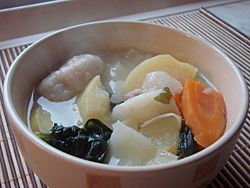Boil up facts for kids

Boil up
|
|
| Alternative names | Pork and Puha |
|---|---|
| Type | Soup |
| Place of origin | New Zealand |
| Main ingredients | Stock, meat, starchy vegetables, leafy vegetables, dumplings |
Boil up is a special traditional meal from the Māori people of Aotearoa New Zealand. It's a hearty and delicious dish, often described as a type of soup or stew. It's made by boiling different ingredients together in one pot.
Boil-up traditionally includes a balanced mix of meat and bones, usually pork. It also has green vegetables like puha, watercress, or cabbage. Starchy vegetables such as kūmara (sweet potato) or potatoes are also added. Everything is boiled together, along with flour dumplings known as "Doughboys".
How Boil Up Started
Long ago, in Polynesian cuisine, people cooked food by dropping red-hot stones into wooden bowls. This was good for heating liquids, but not strong enough to cook tough foods like taro or pork. These foods were usually cooked in an earth oven, which is a pit dug in the ground.
The ancestors of Māori brought these cooking traditions to Aotearoa. They made puddings from grated kūmara or mashed kiekie flowers in large wooden bowls.
When European settlers arrived from Europe, they brought new foods and iron cooking pots. Pigs and potatoes from Europe quickly became popular with Māori. Māori grew large amounts of these new foods to trade with the settlers.
Settler homes often didn't have built-in ovens like those in Europe. So, most cooking was done over a fire using a cast iron pot called a cauldron or a camp oven. These camp ovens were very popular with Māori from the 1850s. They were easy to carry by canoe or by hand. They could stand on three feet in the hot embers or be hung over a fire.
Camp ovens were used for making puddings with flour and sugar, baking traditional rēwena (a type of Māori bread), and for the very first pork-and-potato boil ups. This is how the traditional boil up we know today began!

